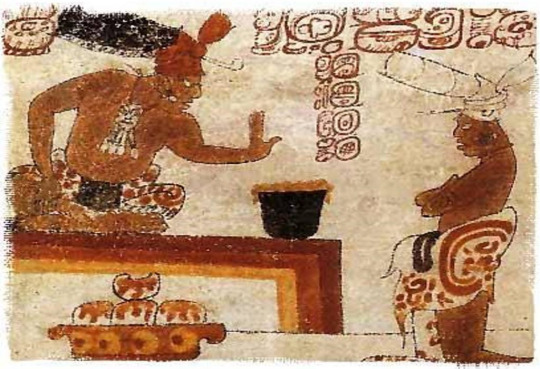#cacaohistory
Text
Cacao in Mesoamerican Society
Chocolate is arguably the most popular confection in the western world. The Swiss alone consume an average of 19.8 pounds of chocolate per person annually. However, chocolate wasn’t always a mass produced confectionery. For centuries, chocolate was produced in small quantities for a select group of people. Cacao’s botany resulted in cacao and chocolate being used to reinforce social hierarchies and connect humans with the gods.
Cacao’s botany had unique social, political, economic, and societal implications for Mesoamerica. However, before discussing cacao’s effects on Mesoamerican societies, it is important to understand the origin of cacao cultivation and nature of cacao production. Cacao was first cultivated by the Barra people of Soconusco, Mexico, a civilization that predates the Olmec; the Olmec then perfected the processing of chocolate, and this process spread to other civilizations. Cacao is particularly difficult to cultivate. For starters, cacao only grows within 20° of the equator in a temperature range of 60℉ and 95℉; furthermore, cacao trees can only grow in shade, and must be planted under larger trees for protection against the Sun. After some time, cacao trees will start to produce flowers; only 3 of every 1,000 flowers on a cacao tree will become cacao pods. Once the cacao pods are mature, they must be delicately harvested by a large workforce, using machetes to carefully separate the pods from their roots. After being harvested, the cacao pods are cut open, revealing the cacao beans, the component used to make chocolate. Cacao beans must undergo a series of steps to be consumable, including fermentation, drying, roasting, and winnowing. First, cacao beans are left to ferment for several days to remove the pulp from the beans. Next, the beans are dried out in the Sun; the length of this drying period depends on the weather. After being dried, the beans are roasted. Next, the beans are winnowed; winnowing is the process in which the edible cacao nibs are separated from the inedible shells. Finally, the nibs are ground and blended; this resulting liquid, called chocolate liqueur, is molded into the desired shape, creating chocolate. The limited growing region and intensive processing of cacao meant that chocolate in Mesoamerica was a limited commodity.
As stated earlier, cacao’s botany led to it being a limited good in Mesoamerican societies. This, in turn, resulted in cacao being used to reinforce societal hierarchies. As cacao was a limited good, only nobles could readily afford it. Chocolate was also difficult and time consuming to prepare; instead of producing the chocolate themselves, nobles had servants prepare their hot chocolate beverage. To further show off their wealth, nobles had their chocolate drinking vessels intricately decorated with images depicting cacao being served to nobles and the gods. The image below is an example of how chocolate was used to reinforce social hierarchies. In the painting, the man serving the chocolate is kneeling, while the man consuming the chocolate is sitting on a throne, showing a class difference between the two. Historians know this beverage is chocolate due to the foam on the top of the drink, as various accounts describe Mesoamerican chocolate as being a frothy drink.

Additionally, the Mexica, also known as the Aztecs, used cacao beans as a form of currency. According to the Codex Mendoza, 4 1⁄2 hours of work was equivalent to 1 cacao bean. When a Mexica noble drank a cup of chocolate, they were literally drinking money, reinforcing their status as the elite.
Not only was cacao used to reinforce social hierarchies, but it was also used to connect mankind to the gods. In the Maya myth of origin, cacao was one of the primary ingredients used by the gods to create mankind, along with yellow corn, white corn, and paxtate. This link between humans and the gods was strengthened further with cacao’s importance in the continuation of the life cycle. In the Madrid Codex, the gods are displayed as watering cacao trees with their blood; when humans consume cacao, they are nourished by the gods. In order to nourish the gods in return, humans would offer chocolate and other foods to the gods during festivals like the Five Dangerous Days; these ceremonies were key in continuing it. Cacao trees also featured in the pantheon of sacred trees, trees which were responsible for holding up the sky and connecting it to the earth, acting as a pillar between the two realms.
Cacao held great significance in Mesoamerican society. As a result of cacao’s limited growing region and labor-intensive cultivation process, cacao was a limited commodity. This led to cacao being used to reinforce social hierarchies and connect mankind with the gods.
Works Cited
Castillo, Lorena. “The Most Surprising Chocolate Statistics and
Trends in 2024.” Gitnux.org, December 16, 2023.
Juarez-Dappe, Patricia. “Cacao Origins.” YouTube, August 21, 2020.
https://www.youtube.com/watch?v=y3NoKpG2PtU
Juarez-Dappe, Patricia. “Chocolate Encounters.” YouTube, August 26, 2020.
https://www.youtube.com/watch?v=G8BW-HHWI88
1 note
·
View note
Photo

If you are interested in Mesoamerica and it’s vast culture from production to livelihood come by California State University of San Bernardino tomorrow from 10 AM to 3 PM. It’s open to the public, and what a way to start the session, but with chocolate! El Buen Cacao will be up first with a talk on chocolate and it’s origins in Mesoamerica. Come on by tomorrow and learn about this amazing culture that, among other things, introduced chocolate to the world! . . . #elbuencacao #beantobar #chocolate #presents #mesoamerica #cacaoorigins #chocolateorigins #cacaohistory #theobromacacao #foodofthegods #csusb #welovechocolate #calstate #sanbernardino #inlandempire #smalltalk #networking #presentation #ebc https://www.instagram.com/p/Boja1OnnxEv/?utm_source=ig_tumblr_share&igshid=m6evuuv5qhng
#elbuencacao#beantobar#chocolate#presents#mesoamerica#cacaoorigins#chocolateorigins#cacaohistory#theobromacacao#foodofthegods#csusb#welovechocolate#calstate#sanbernardino#inlandempire#smalltalk#networking#presentation#ebc
0 notes